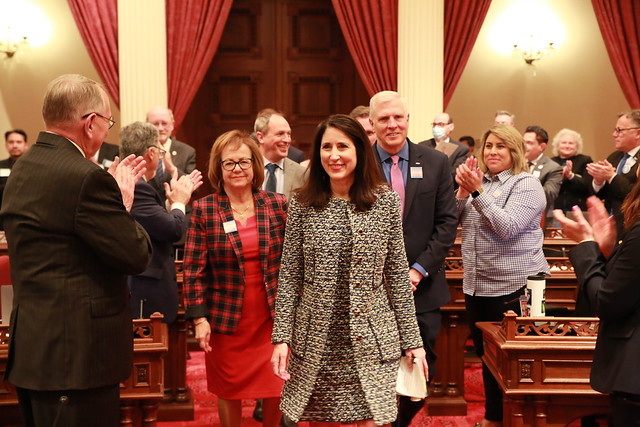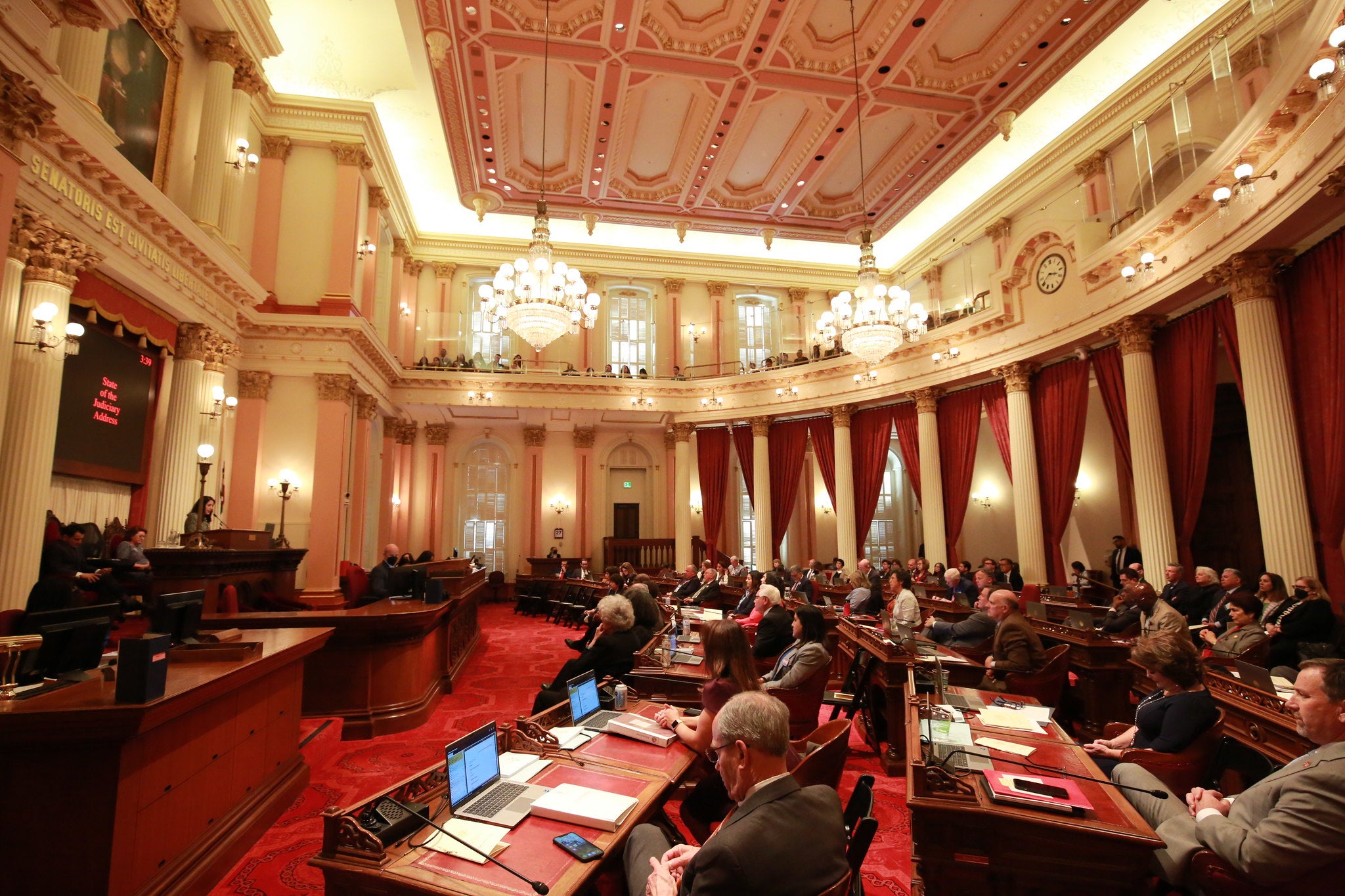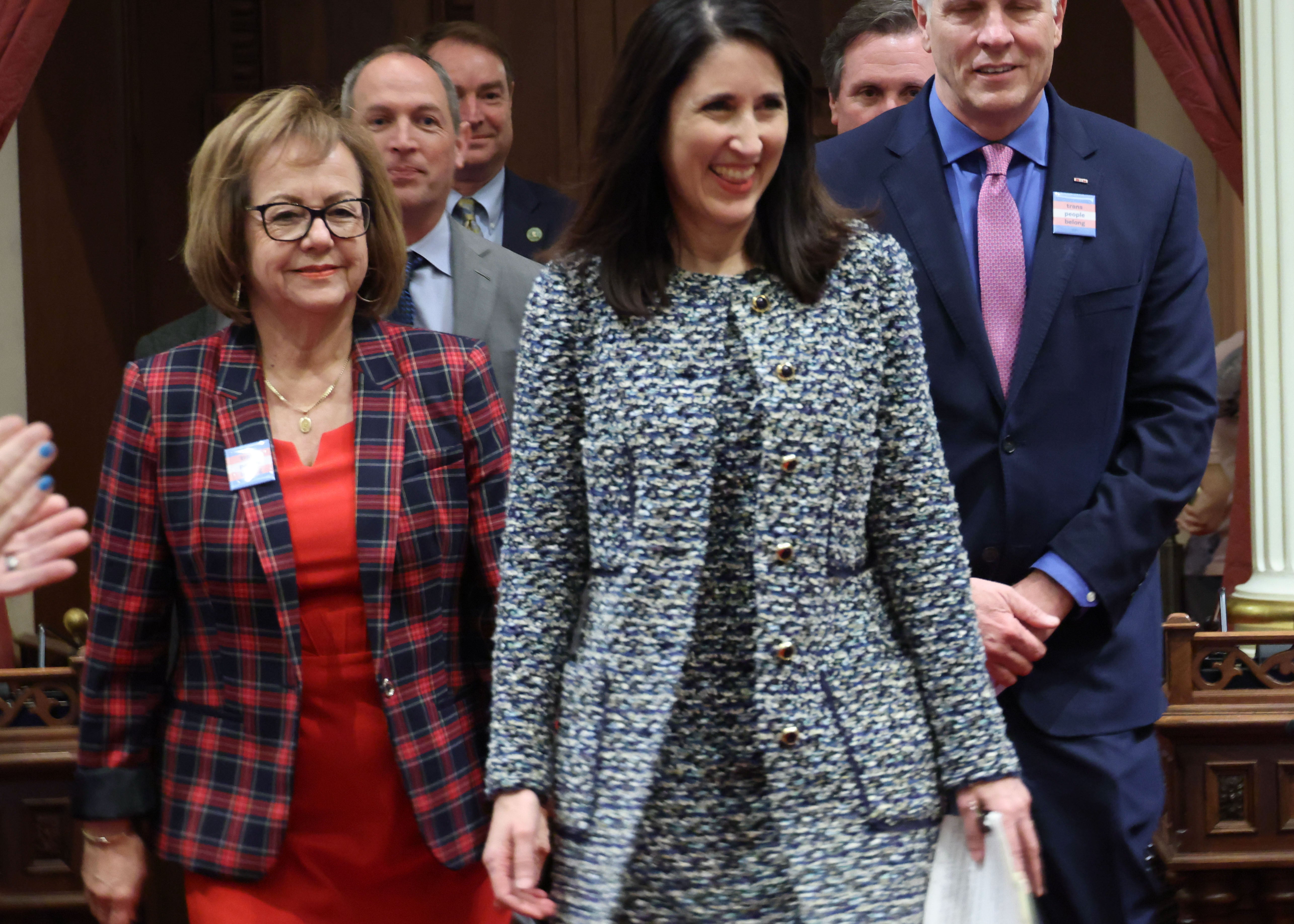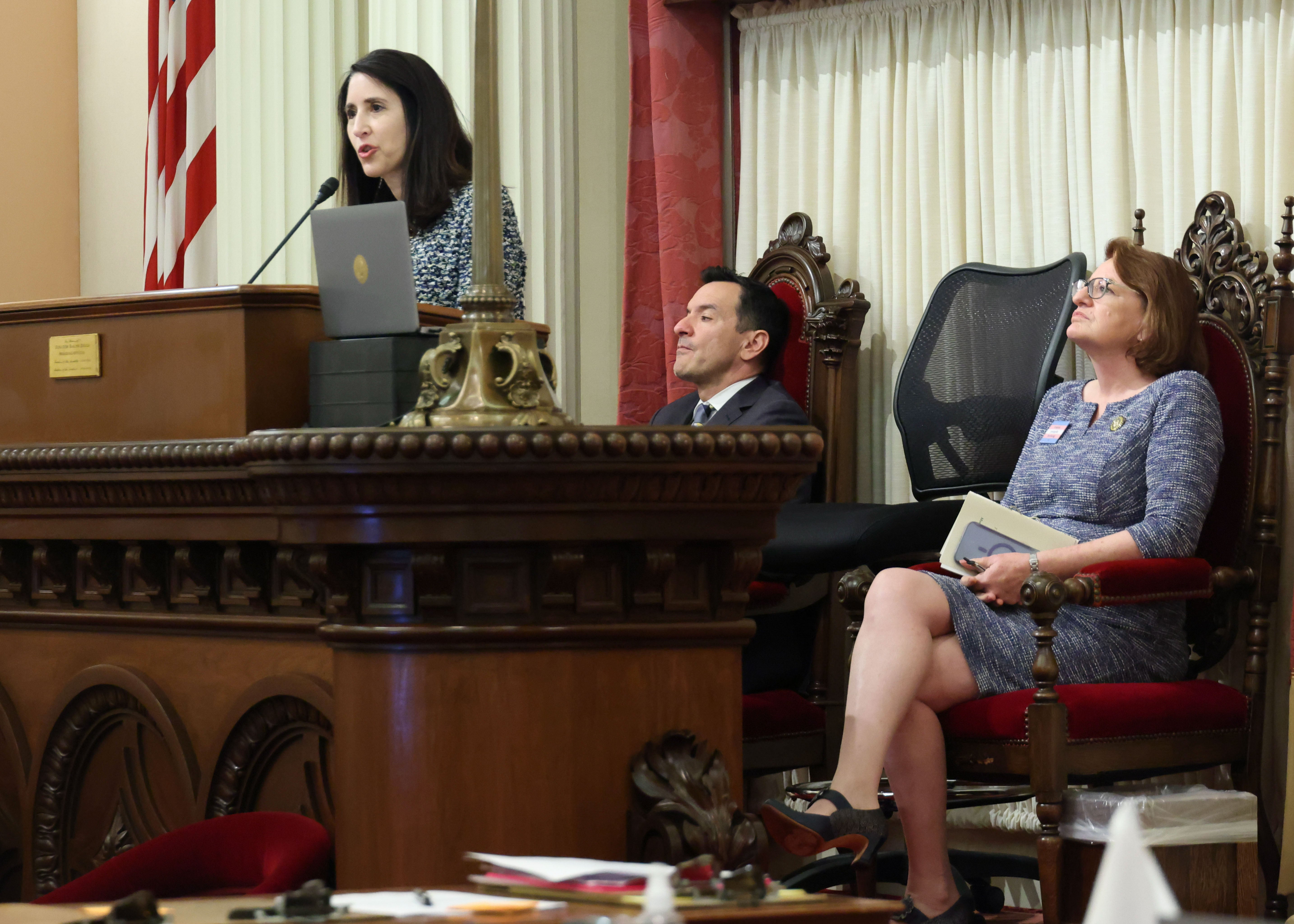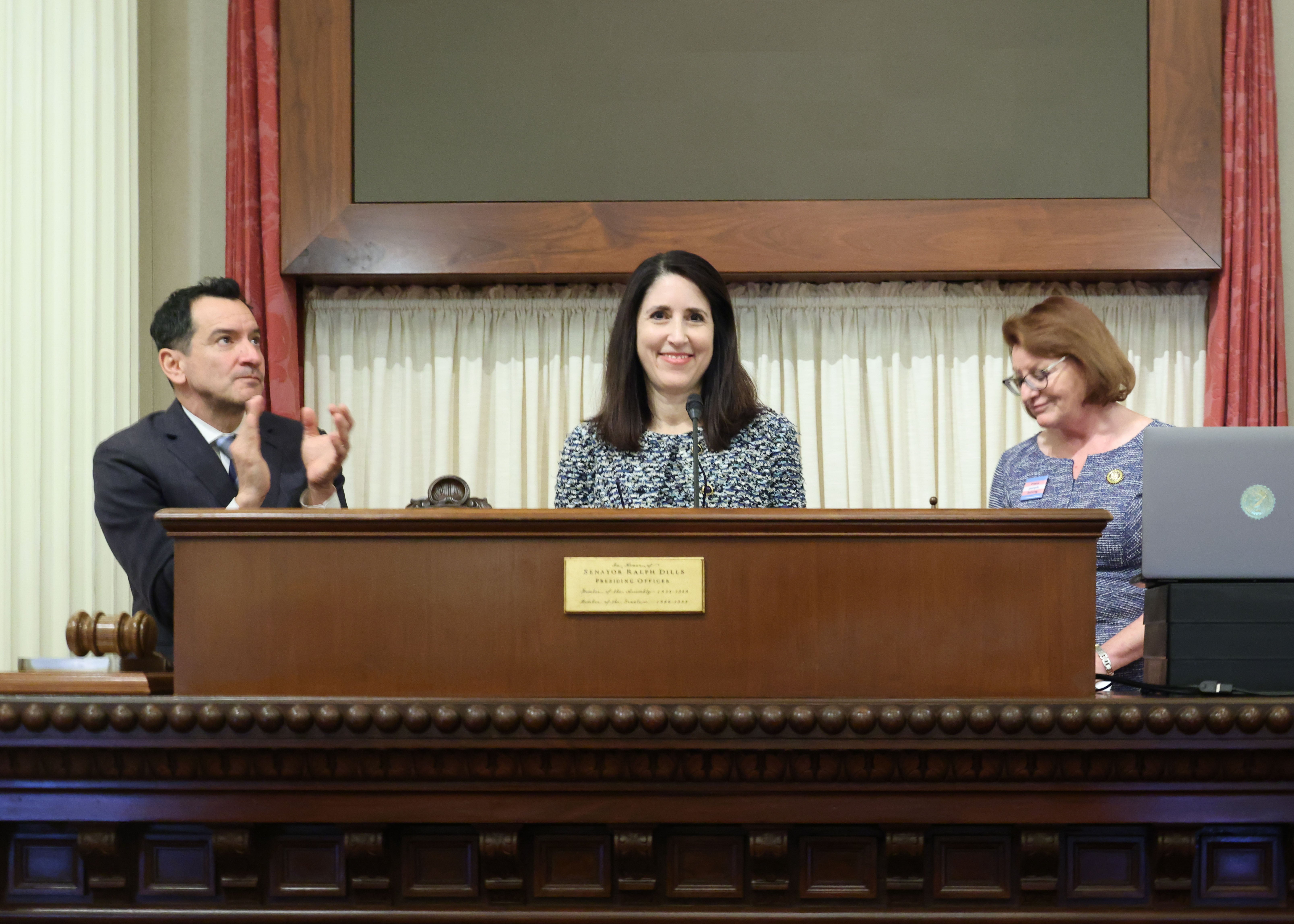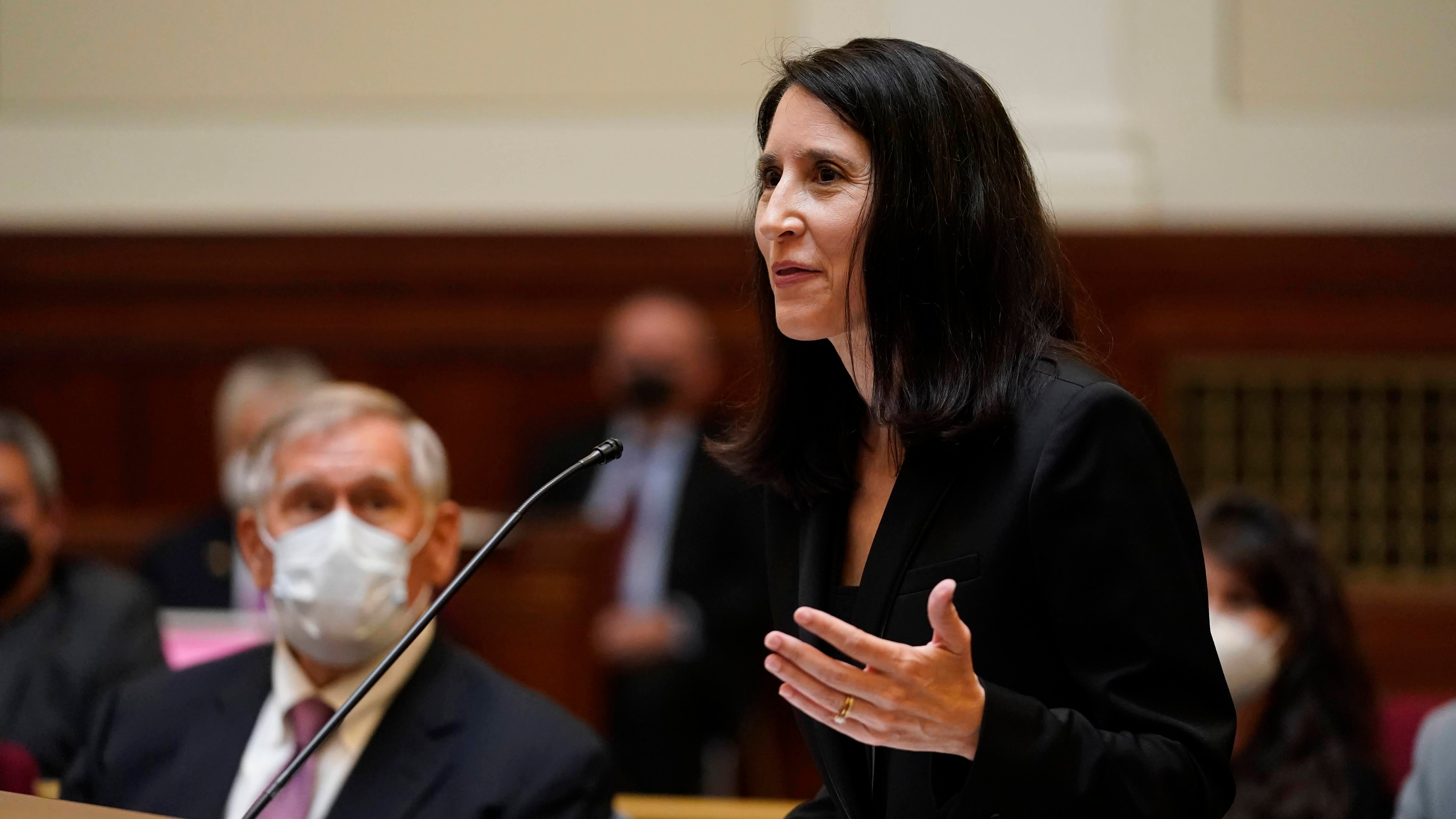California Chief Justice Delivers 2023 State of the Judiciary Address
SACRAMENTO—Chief Justice Patricia Guerrero today delivered her first State of the Judiciary address to the California Legislature. The transcript of her remarks as delivered is below. Listen | Watch
Thank you Senate President Pro Tem Atkins, Speaker Rendon, Attorney General Bonta, and of course, Governor Newsom.
I am proud to be with you here today and with my colleagues and staff from the Supreme Court; justices, judges, and court executives from throughout the state; the Judicial Council; the California Judges Association; the Bench Bar Coalition; and our justice system partners and stakeholders.
I am especially thankful that my family is here (or intended to be). My husband Joe—who is my biggest supporter—and our two sons Anthony and Christopher—our greatest source of pride.
And during the first State of the Judiciary Address by a Latina Chief Justice of California, I would like to say: ¡Bienvenidos a todos! Sobre todo quiero darle las gracias a mi papá, que no pudo estar aquí pero que está en mi corazón y siempre me apoyá.
I was honored to be nominated by Governor Newsom as California’s 29th Chief Justice—the third woman and the first member of the Latino community to hold this position in our constitutional democracy—and to be elected to a 12-year term by a vote of the people of California.
I would like to share with you, and with any of the voters who may be watching, a little bit about myself before discussing the judicial branch.
I am from the rural town of Imperial in the Imperial Valley, the daughter of Mexican immigrants. Like so many other immigrants to this great country, my parents came here to escape poverty and to build a better life for themselves and the family they hoped to have. They sacrificed and they struggled to give me and my sister, Claudia, a better life—and the privilege of being able to pursue the American Dream. For that, I am forever grateful.
I learned the importance of hard work and perseverance from my parents. For my dad, Jorge, it was tough, back-breaking, manual labor in the heat of the Imperial Valley—working as a cowboy, taming wild horses, working as a farrier, and competing in rodeos. As a child, I always thought he worked that hard because he simply enjoyed it—since he never complained about the grueling work and the long hours. He later explained to me that he worked hard because he had to, so that I could work doing something that I love. I now have the privilege to be able to do that and hope to apply that same work ethic that I saw my father model.
My mother, Armida, cared for neighborhood kids in our home and later volunteered in an elementary school. She was my role model for strength and independence. She was an avid reader, who taught me the importance of an education. She taught me it is important to help people who are less fortunate than you, no matter what your own station in life may be. And I have tried to emulate the kindness and generosity toward others that I saw my mother and my sister emulate.
Although neither of my parents had much of a formal education, they taught my sister and me valuable life lessons. They taught us to value our family and our culture. They taught us to thank God for the many blessings that we have. They taught us to believe in ourselves, and to have compassion for other people. They taught us never to look down on others, and to never let anyone look down on you. And both of my parents encouraged us to follow our dreams.
My dreams were shaped in part by one of my teachers who told me that if I continued to do well, I could go to a good college like Berkeley or Stanford—and I was fortunate to be able to go to both.
I started work in a local grocery store in the Imperial Valley when I was 16 years old. When I got into Berkeley, the first thing I did was go to a grocery store to get a job there. I financed my education through scholarships and part-time employment, working more than 20 hours a week.
I earned my law degree from Stanford Law School. After graduating, I worked as an associate at a major law firm in San Diego and later at the same firm in San Francisco. I served in the U.S. Attorney’s Office as a federal prosecutor, and then I did return to the same law firm in San Diego where I made partner and focused on complex litigation matters. While in private practice, I still did pro bono and volunteer work that ultimately led me back to public service in the Family Law Division in the San Diego Superior Court, then on the Court of Appeal, and now the California Supreme Court.
That’s a brief overview of my path from the Imperial Valley to the California Supreme Court—where, as of today, I have now been in office for 85 days! Although the details may differ—it’s a story common to many immigrant families who came to call California home. And it’s the idea, as Governor Newsom describes it, that every person can achieve a better life in our state regardless of where they came from.
I recognize that I did not get here alone, and many others have helped to pave the way.
I would like to thank my predecessor Chief Justice Tani Cantil-Sakauye. Appropriately during Women’s History Month, I would also like to highlight the fact that this is the first transition of judicial leadership from one female Chief Justice to another. And from one person of color to hold this position to another.
We are both the beneficiaries certainly of our own hard work, but also a decades-long commitment to building a pathway to the bench for qualified minority candidates by successive governors, the legal profession, and the judicial branch in partnership with bar associations and educators.
That commitment required a pathway to become an attorney, which before that, required a belief by young people throughout the state that they could and should join the legal profession. And it required action by successive governors—in my case, former Governor Brown and Governor Newsom—to consider, promote, and encourage qualified applicants for appointment to the bench.
I expect there will be more appointments and transitions like this, and with other variations in the future, and I certainly look forward to the second, third, and fourth occasions—as what has been, and still is in some ways, exceptional becomes “normal” in all areas of public service throughout our state.
As I embark on my own tenure as Chief Justice, I will be informed by the lessons of my predecessors and their dedicated work.
Chief Justice Cantil-Sakauye weathered the storms of the Great Recession and a global pandemic and brought greater predictability and accountability to the judicial branch budget. Chief Justice Ronald George strengthened the judicial branch with the creation of a single level trial court system, and a transition from county to state court funding. And Chief Justice Malcolm Lucas did the same with his strategic planning for the judicial branch. And Chief Justice Rose Bird helped generations to come by breaking gender barriers in the courts.
Four leaders who built on the foundation for improving the administration of justice and enhancing fair and equal access to our court system for all Californians.
I too hope to continue their important work. And now, I am privileged to serve on one of the most talented and diverse high courts in the nation—a collegial bench with a broad range of backgrounds and experience—all committed to justice and the rule of law.
And perhaps one of the most innovative of state high courts, setting precedents in criminal justice, civil liberties, racial integration, and consumer protection that influence other states and even the federal bench. Seventy-five years ago this year, the California Supreme Court in the matter of Perez v. Sharp ruled the state’s ban on interracial marriage unconstitutional, and this occurred nearly two decades before the United States Supreme Court’s landmark decision in Loving v. Virginia, which finally struck down similar laws throughout the United States.
Every day the dedicated public servants in the judicial branch work to provide fair, equal, and accessible justice to all Californians, no matter who they are or where in our state they call home.
They are all served by seven state Supreme Court justices (with 146 staff); six regional district Courts of Appeal (with 106 justices and 762 staff); 58 county trial courts (with 2,005 judicial officers and 17,272 employees, all working out of 447 trial court facilities); 28 members of the Judicial Council (with 740 staff)—all serving nearly 40 million Californians.
Whether you come from urban, suburban, or rural populations; coastal, inland, or mountain communities; agricultural, industrial, or technology centers—all of these communities and locations are served by California’s courts. They are served by judicial officers, who like me on January 2, took an oath of office “…to support and defend the Constitution of the United States and the Constitution of the State of California against all enemies, foreign and domestic…”
It is an oath that I proudly share with all of you in the Legislature—many of whom I had the opportunity to administer the oath of office to in December. Our shared commitment to public service, the rule of law, and equal access to the opportunities provided to all Californians in this most diverse state in the nation continues to be focused on fairness, equity, and inclusion.
I know that just like me, 34 of you are new to your roles in the Legislature or have changed roles between the Assembly and the Senate. So I invite you, and indeed all the legislators, to visit your local trial court through the Judicial Council and California Judges Association’s Day on the Bench Program to really learn more about how your constituents access their local courts and how the courts serve your communities.
As former United States Supreme Court Justice Sandra Day O’Connor once noted: “The executive branch has the power of the sword, the legislative branch has the power of the purse, and the judicial branch has the power of the quill.”
The executive and legislative branches enacted approximately 1,200 new laws in 2022, and many of them take effect in 2023. The judicial branch—our courts—interpret those new and existing laws and create case law through decisions that help to clarify the law and to provide uniformity for their future use or application.
And that is how our constitutional democracy works and succeeds—with defined duties, roles, and responsibilities combined with necessary checks and balances between the branches of government—all in service to the people.
In terms of my own duties and responsibilities, as Chief Justice of California, I wear three hats, as many of you know. And for those of you who don’t, it means my work effectively tripled starting in January. In addition to serving as one of seven justices of the Supreme Court, with additional administrative responsibilities for the court, I also lead the judicial branch and collaborate and advocate with our sister branches of government. And I chair the Judicial Council of California, which is the policy and rule-making body for the judicial branch.
In my role as Chief Justice and chair of the Judicial Council, I want to thank former Administrative Director Martin Hoshino, and the current Judicial Council leadership team—Justice Marsha Slough, Justice Carin Fujisaki; Judge Marla Anderson, Judge Kyle Brodie, and Judge David Rubin. And Judicial Council and advisory committee members; and Acting Administrative Director Millicent Tidwell and her Executive Team for facilitating the smooth transition of leadership within the judicial branch.
Being a Judicial Council member is like having a second voluntary job, and I stress voluntary. Because of their dedication to public service and to improving the administration of justice, combined with the quality services and access provided by courts throughout California, the state of the judiciary is strong.
I plan to continue the collaborative work among the three branches of government, to maintain and enhance the positive working relationship that has led to three-branch solutions to address many issues facing our state and its people.
There are many pathways that lead to interaction with our justice system—some are more challenging than others. So I applaud Governor Newsom and all of you for your efforts in exploring ways to address the needs of Californians with untreated mental health, substance abuse challenges, and in crisis to gain access to housing, treatment, and care. And the judicial branch will continue to play its role in supporting efforts through initiatives like our collaborative courts.
The collaboration and collaborative three-branch solution process we have in California government has also had a positive impact on the judicial branch budget in terms of available resources and stable funding to improve and expand court services.
Transparency and information sharing with you and with the Administration, facilitating critical support from justice system partners, and improving fact-driven, data-driven decision-making has enhanced meaningful access to justice.
Together, our collective efforts have made great progress toward achieving adequate, stable, and sustainable funding for the courts in recent years. The judicial branch budget as many of you know makes up 1.7% of the total state budget. We’re doing a lot with those taxpayer funds in the local communities that we all serve.
As it should in good government, these critical ongoing investments come with increased accountability in reporting trial court and budgetary operational metrics. This year we provided our year-one report to all of you in the Legislature on Trial Court Operational Metrics with various specified operational and budgetary data. And I look forward to more information sharing and discussions as we work through this year’s budget process.
We do so against the backdrop of working to adapt to a post-pandemic environment. Governor Newsom declared an end to the COVID-19 State of Emergency last month. And while the impacts are still being felt by many, we are carrying forward the lessons learned from the necessity of having to change how we traditionally provided services during COVID.
The most striking of these lessons learned for the judicial branch is remote access. Remote access to services; remote access to case information; and remote access to hearings and proceedings.
For many years the judicial branch has been focused on three fundamental principles for access to justice: (1) physical access, (2) equal access, and (3) remote access. We have been moving from in-line to online whenever we can do so in the most effective way and when permitted. While we were using the funding provided by you with Innovation Grant funding and developing strategic and tactical plans for technology, society was also evolving around us.
The courts serve all of the generations. I won’t go over all of them, but from the Golden Generation to what my son was telling me—the Alpha Generation—and future generations to be named.
And we must continue to meet people where they are.
The younger generations are digital natives—they expect to access services, and their government, not just online, but on their smartphones—and they make up half of our nation’s population.
So we have experienced the need to adapt because of COVID, but also because of the changing demographics of court users and how they want to interact with us.
But what we learned during the pandemic is that “remote” worked for pretty much everyone involved. There are still challenges with the digital divide and technology, but we can work together on solutions that are fair, equitable, and just.
Feedback that we have received from the use of remote technology in trial court civil actions was overwhelmingly positive. Courts held more than half a million civil remote proceedings over a seven month period, and more than 96% of those remote users reported they had favorable experiences.
Other data shows that:
- All 58 county superior courts are able to hold proceedings remotely in at least one case type and 39 courts in all or most case types;
- Juvenile delinquency and dependency users reflect that case clearance rates improved over pre-pandemic levels, and the youth participants in these cases preferred the online experience rather than having to appear in court;
- Vulnerable court users, like victims of domestic violence and elder abuse, reported that they had less anxiety and stress by not having to come and appear in court with their alleged perpetrator;
- Collaborative court participants also were able to appear without disrupting drug or medical treatment; and lastly
- Remote proceedings also helped with equity and fairness issues for people who otherwise would have to miss work, travel long distances, or incur transportation or other expenses in order to make brief proceedings.
The Supreme Court and the Judicial Council also leveraged technology to conduct remote proceedings and business meetings, and now can accommodate a hybrid participation to get the people’s business done.
Beyond technology, we are all also keenly aware of another major transformative driver—and that is the impact of climate change on our world, nation, and state. With our western-state neighbors, we are dealing with the ongoing issue of access to water for our communities and industries.
Thanks to your support, the Judicial Council has created an environmental program that’s focused primarily on water law issues. This past year we provided water law education programs and made resources that were available across the state.
We are following up on these efforts with an Environmental Law Summit this summer, along with publications, podcasts, and more training on issues related to the complex areas of water law, climate change, and environmental litigation.
And with this expanded focus, we will be better able to contribute to the broader policy discussions on water issues and their interaction with the court system.
As I mentioned earlier, California’s court system continues to become more diverse and more reflective of the wide variety of communities we serve. At every level of court operations, it’s now possible for a member of the public to see someone who looks like them, or who has a background and identity like them.
Our state’s diversity is a strength. For the 17th straight year, the data shows a steady increase in the number of women and judges of color. Female judicial officers now constitute nearly 40% of all judicial officers. The percentage of Asian, Black, and Hispanic judicial officers nearly doubled since 2006 when we began keeping data. We’ve made progress and have established a solid foundation that we can continue to build on into the future.
Last December, the Judicial Council voted to amend our Judicial Branch Strategic Plan to further elevate and embrace our representation and responsiveness to individual and group differences to leverage diversity to foster an environment of respect and engagement. And what we did was added “inclusion” to our number one judicial branch goal.
An inclusive court is one in which all individuals are—and more importantly feel like they are—respected and engaged. So our number one goal now is Access, Fairness, Diversity, and Inclusion.
Last year, through a legislative bill, we included Native American Day as a judicial branch holiday. This year, for the first time, through another bill that the Judicial Council supported, we will be celebrating Juneteenth as a state holiday. This coming Friday, we recognize César Chávez Day. These and other such recognitions are reminders of the importance of the work on Access, Fairness, Diversity and Inclusion that is ongoing through initiatives across the branch.
The Judicial Council’s Advisory Committee on Providing Access and Fairness is also developing a Racial Justice Toolkit for courts. We’re working on expanding gender-neutral forms. Education on unconscious bias and the prevention of discrimination and harassment is now mandatory for all judicial officers. And we’re continuing to expand language access services.
The list goes on, and the work goes on.
Some may ask why I choose to emphasize diversity in my first State of the Judiciary Address as Chief Justice of California. My answer to you is because it is important. I would like to share a story regarding one of my recent outreach efforts where I was participating in a program where I visited with an elementary school through the Power of Democracy program. The students were learning about the three branches of government and the judicial branch’s role in upholding the rule of law. Before I arrived, one student who did not speak English, was told by one of his classmates who was translating for him that someone like him was now Chief Justice of California. He and I were introduced, and we had an opportunity to talk—the lesson for him was concrete. For that young student, and for others like him, I believe it matters that they can see some of themselves in the members of our courts.
When they look to this court, I believe they will also see a long tradition of judicial excellence. I hope to contribute my own voice and strengths to that rich tradition of leadership as I embark on my tenure as Chief Justice of California.
In my role, I will strive to learn from my predecessors. I will reconsider past practices, look for areas of improvement, and be transparent and accessible—in short, I will remain committed to access, fairness and equal justice.
Some of my priorities include:
- Safeguarding and enhancing public confidence in the judiciary—through programs like our Civic Learning Initiative, and mentorship and training efforts;
- Increasing access to justice—including through the use of technology and increased provision of pro bono legal services;
- Increased transparency, improving efficiencies, and increasing productivity without sacrificing quality; and
- Advocating for a stable budget that the judicial branch can continue to count on to make public access to justice a reality in all 58 counties
In short, learning from the past, continuing our reputation as the finest state court system in the country, and holding my office in trust and safeguarding it for the next Chief Justice and the next generation of leaders.
And I invite all of you to join me in that journey, because together we can make a difference.
I would like to close with a word about my mother. My mother made everyone in her world feel seen and included. She passed away from breast cancer nearly three years ago and before I was able to share this experience with her. In my address to you here today is a tribute to her—her American Dream realized!
The experiences of both of my parents raising a family in Imperial Valley—living in an immigrant community with what on the surface appeared to be limited resources and opportunities—taught me the importance of caring for others, rather than just looking out for your own selfish interests.
As Dr. Martin Luther King Jr. expressed in his sermon titled “Three Dimensions of a Complete Life”, life’s most persistent and urgent question is, “What are you doing for others?”
It’s my answer to Dr. King’s question, and the lessons from my parents, that has brought me here together with all of you today—a collective of individuals dedicated to public service, a collective of individuals committed to doing good and what is right for others.
Let’s continue to work together collaboratively, let’s continue to question the issues and search for possible solutions, and let’s continue to focus on the good that we can do for the Californians we all serve.
Thank you for listening.


